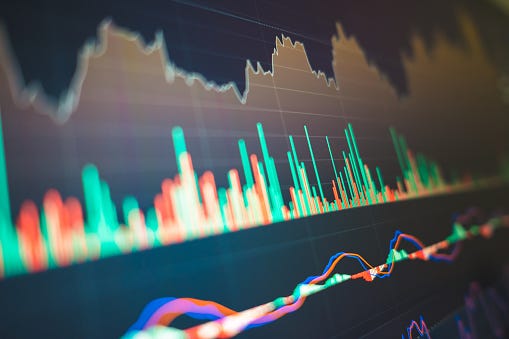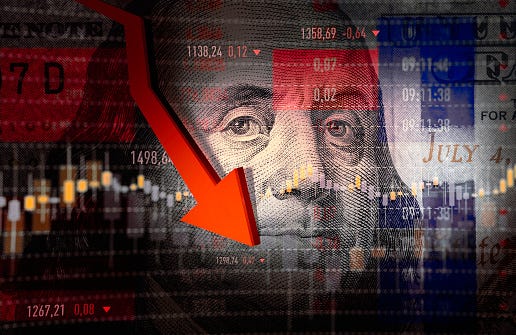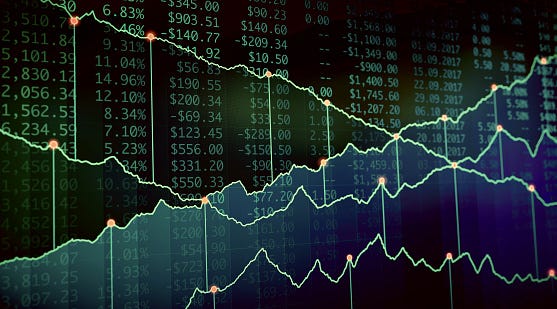The old lousy adage, “The rich get richer, as the poorer get poorer “ may not be the case anymore. Welcome to 2022, where “the richer get eaten, as the poor get snackin”, for now…
With the top 1%’s billionaires shedding a collective $50 billion+ this year alone due to the market’s sell-off, crypto plunging, real estate bubble flattening, unicorn valuations deflating, and IPO/SPAC listings called off, public company founders and executives, in particular, don’t see smooth sailing in the short-term, especially when it comes to the metaverse.
Unfortunately, when you change your company’s name to Meta, it can’t be switched that easily. You got to stick with the blurred costly vision for the long haul. That’s investing after all!
Although capitalism presents a stark divide in our economy and country between the have and the have-nots and the pandemic has only exacerbated the wealth, gender, racial, and pay gaps, since Jan 2022, the bottom 50% of Americans have witnessed an unexpected financial surprise from souring markets and are emerging more resilient and financially logical than the top 1% who pay less taxes than them.
Yes, you heard that right. The bottom 50%, not the top 50% are gaining the most from a declining market. This is true hedging at its finest!
Sadly in this zero-sum game of the 21st century, when one benefits, it tends to be at one’s detriment or loss. In order for markets to function and be stable, transactions need to occur between a buyer and seller however more often than not, someone always bites the other person in the least unexpected ways.
Whether it be in a real estate transaction where the buyer has to deal with a stubborn seller who refuses to negotiate the closing price and wants to rush to get it off the market or when dealing with surcharges in a taxi in NYC, most deals aren’t truly fair and can always be further compromised yet life moves on and exchanges need to happen for the world to keep moving!
In this case, markets have flipped on their heads and although it’s not what the majority prefer, the bottom 50% of Americans have seen larger gains than any other income class, particularly the top 1% since the majority of their net worth is exposed to the wild markets and their volatile businesses ventures. Earning a paycheck from an employer isn’t as unstable as one may believe, especially during a downturn with a nice pension.
Depending on your risk tolerance and how much volatility you can stomach, even billionaires might not feel safe relying on their own public companies to keep them on the Forbes 100 list and would much rather work for another stable company they have no stake in instead! Sometimes too much power is self-destrucive, especially when you know it’s up to you to keep your employees and yourself afloat.

Cash is King and You Need More Of It Especially The Wealthier You Are
Too much exposure to anything, from crypto to even cash can be disastrous, especially in inflationary times. If the rich know anything, it’s to keep at least 6–12 months of living expenses or more in cash since what’s certain is uncertainty.
Very few people in the top 10% and above actually hold onto enough liquid cash compared to the bottom 50% since they believe it’s somehow better to just sell their stake in their company even during a declining market or give up their lucrative equity-based compensation package at their company. Another reason is that they may be spooked by cash’s purchasing power decline while the bottom 50%, for good or for bad reasons, own more cash than investments, if not at all, which is currently serving them very well when deployed in the correct places.
Unlike the markets where equities are losing steam by ~20% YTD, allocating a portion of your capital to a variety of places is an optimal move. These cash-equivalent investments can include short-term treasury bills, money market funds, CDs, or I Savings Bonds which are paying a whopping 9% guaranteed return backed by the US government! Safest investment possible!
With the current yield inversion, instead of fretting about another possible recession, take advantage of these uncommon moves in the market and purchase 3–4 month treasury bills yielding ~4%, an 11-yr high today!
Although fixed-income gets a bad rap for being too conservative, I would choose a 4% yield that pays me every 3–4 months or 9% every year any day than a ~20% or 20% once in a blue moon!

Rise to the Top
According to the Realtime Inequality tracker, the bottom 50% of US households, who have a net worth of $166k or less, are in one of the strongest financial positions in a generation.
The bottom 50% of earners and workers have the least amount of exposure and their net worth tied to the public and private markets, if not at all. Clearly, this isn’t a prudent nor realistic way toward financial freedom or success, however during this paradoxical year, less equity-exposure acts as a surprising tailwind!
For context, the bottom 50% income class holds the least amount of cash on hand, carries toxic (car, credit card) and good debt (mortgage, student loans), and tends to work pay-check-to-paycheck and earn below the national average. I cannot even imagine the amount of physical and mental stress this bears on hard-working people.
Although they fall into the lowest tier of taxpayers and save more of their income, this doesn’t mean they can easily stay afloat.
They deal with immense financial challenges starting with the basics. Since most only rely on one paycheck in the household and inflation eats at that single paycheck, budgeting is the toughest challenge.
Especially without any ownership of any investments, even an asset such as their primary residence that they may not even have sizable equity in, it can be tough to survive especially when the regressive tax rate bites into everyday staple goods such as gas and food which for the bottom 50%, take up a sizable chunk of their paycheck each month.

Reversal
So how did the bottom 50%’s wealth grow by 2.8% through the first 6 months of the year despite soaring inflation, stagnant wages, and looming recessionary fears?
Compared to the middle 40% of earners who saw their wealth plunge by 4.9% while the top 1%, most heavily exposed to the market lost more than 10%, the bottom 50% take the least amount of risk. Funny enough and this is not recommended, the reason they were able to see a reversal in their wealth was due to less diversification, extra cash sitting on the sidelines, and dependency on an employer.
What’s terrifying about our behavior is that the more risks we take and rewards we happen to gain as a result of them, the more we falsely convince ourselves next time we can handle even more risk and those gains will top anything we’ve seen before.
Especially when one has more than a sizable cushion and disposable income that can cover them for months if not years on end, these folks no matter how great of an investment track record they’ve had in the past, believe they will win again and find the golden goose, a false mindset trap.
Spoiler Alert: Never attach your emotions to your decisions and believe you can beat the market or the Fed. It rarely happens and even prized hedge fund managers who charge 2% of AUM and 20% in performance fees have a tough time doing so. As a result, passive investing historically beats out active investing for this reason. Be in it for the long game otherwise, it’s not worth your time or sanity.
When you have less of anything, you may very well be more secure than anyone willing to gamble millions and bet on the market’s decline. Remember, too much of anything is dangerous.
Overconfidence can lead to disillusion, especially the more money you have. Mo money can easily create mo problems as well. Read here to find out why.
Not only is excessive exposure and too much risk in the markets avoided at all costs by the bottom 50% due to a lack of financial literacy rates which we want to change ASAP, but also their paychecks which aren’t comprised of equity-based compensation haven’t been slammed as badly from inflation either.
Since wages haven’t kept up with inflation, the bottom 50’s incomes adjusted for inflation increased by 1.3% in the first half of 2022, while the middle 40% fell by 0.2% Since April 2020, real income growth for the lower half of earners in the US has roughly doubled the pace nationwide!
Although there are always two sides to the coin when it comes to working for an employer versus yourself or relying on your investments all together, the bottom half of earners and low-wage workers saw the most gains so far this year because they are agile, adaptive, hold onto cash, and proved to their employers that they are in-demand top talent and have transferable skills across various industries.
They are also the largest subset of the population who’s switched jobs in the lower end of the market. Job hopping is a skill in itself!
Although investing is all about weighing risk and markets have clearly disappointed the creme de la creme, I urge those in the bottom 50% to get started with investing with as little as a few dollars earlier than later since at the end of the day, investing is for the long haul, not a short-term day trading scheme. Clearly you shouldn’t follow the billionaire hedgies. They haven’t been doing so hot since the short-squeeze in Jan 2021 with AMC.
Long-term average passive investors have probably faired better than any billionaire short squeeze option trader altogether.
It’s really the moves and cushion that count. Take care of yourself and put that investment in yourself each day. It yields an unlimited ROI over time.
Oh and last thing. Invest in what you know. According to 2022, don’t just do it for the sake of it or because everyone else is doing it. Go against conventional wisdom to get ahead.

